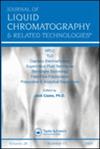Extraction of glucocorticoids from water into acetonitrile using polyol induced extraction with ultra performance liquid chromatography and triple quadrupole mass spectrometry (PIE-UPLC-MS-MS)
IF 1
4区 化学
Q4 BIOCHEMICAL RESEARCH METHODS
Journal of Liquid Chromatography & Related Technologies
Pub Date : 2021-12-14
DOI:10.1080/10826076.2022.2110116
引用次数: 0
Abstract
Abstract Polyol-induced Extraction (PIE) was used for the extraction and UPLC-MS-MS was used for the analysis of glucocorticoids in water. The focus of this work was to demonstrate PIE as an effective technique that allows extraction of solutes between miscible solutes using a phase separating agent, with an example analysis of glucocorticoids. In this work glycerol is used as the mass separating agent in the extraction of glucocorticoids from water into acetonitrile. Eight glucocorticoids were extracted by PIE and analyzed by UPLC-MS-MS. Extraction conditions were optimized, and extraction results were compared to non-extracted glucocorticoid standards and to literature methods. Extraction was optimized at 0 °C, in 10 mL of a 1:1 ACN/Water mixture 2 mL of glycerol added as phase separating agent. Calibration curves showed overall correlation of r 2 > 0.99. Precent relative standard deviation below 4%was obtained for all analytes. Limits of detection were obtained between 3–4 ng/mL by the IUPAC method and 40–200 ng/mL by a propagation of errors method. PIE is demonstrated to be a simple and quick method for extracting glucocorticoids from water into a miscible polar solvent, acetonitrile. Graphical Abstract多元醇诱导萃取-超高效液相色谱-三重四极杆质谱法(PIE-UPLC-MS-MS)从水中提取糖皮质激素
摘要采用多元醇诱导萃取法(PIE)提取糖皮质激素,采用UPLC-MS-MS对水中糖皮质激素进行分析。这项工作的重点是证明PIE是一种有效的技术,可以使用相分离剂在可混溶溶质之间提取溶质,并以糖皮质激素为例进行分析。在这项工作中,甘油作为质量分离剂从水中提取糖皮质激素到乙腈。采用PIE法提取8种糖皮质激素,并用UPLC-MS-MS进行分析。优化提取条件,并将提取结果与未提取糖皮质激素标准品和文献法进行比较。最佳提取条件为:0°C,在10 mL的1:1 ACN/Water混合物中加入2 mL的甘油作为相分离剂。校正曲线总体相关系数为0.99。所有分析物的相对标准偏差均低于4%。IUPAC法的检出限为3-4 ng/mL,误差传播法的检出限为40-200 ng/mL。PIE是一种简单、快速的从水中提取糖皮质激素到可混溶极性溶剂乙腈的方法。图形抽象
本文章由计算机程序翻译,如有差异,请以英文原文为准。
求助全文
约1分钟内获得全文
求助全文
来源期刊
CiteScore
2.80
自引率
0.00%
发文量
29
审稿时长
4.9 months
期刊介绍:
The Journal of Liquid Chromatography & Related Technologies is an internationally acclaimed forum for fast publication of critical, peer reviewed manuscripts dealing with analytical, preparative and process scale liquid chromatography and all of its related technologies, including TLC, capillary electrophoresis, capillary electrochromatography, supercritical fluid chromatography and extraction, field-flow technologies, affinity, and much more. New separation methodologies are added when they are developed. Papers dealing with research and development results, as well as critical reviews of important technologies, are published in the Journal.

 求助内容:
求助内容: 应助结果提醒方式:
应助结果提醒方式:


